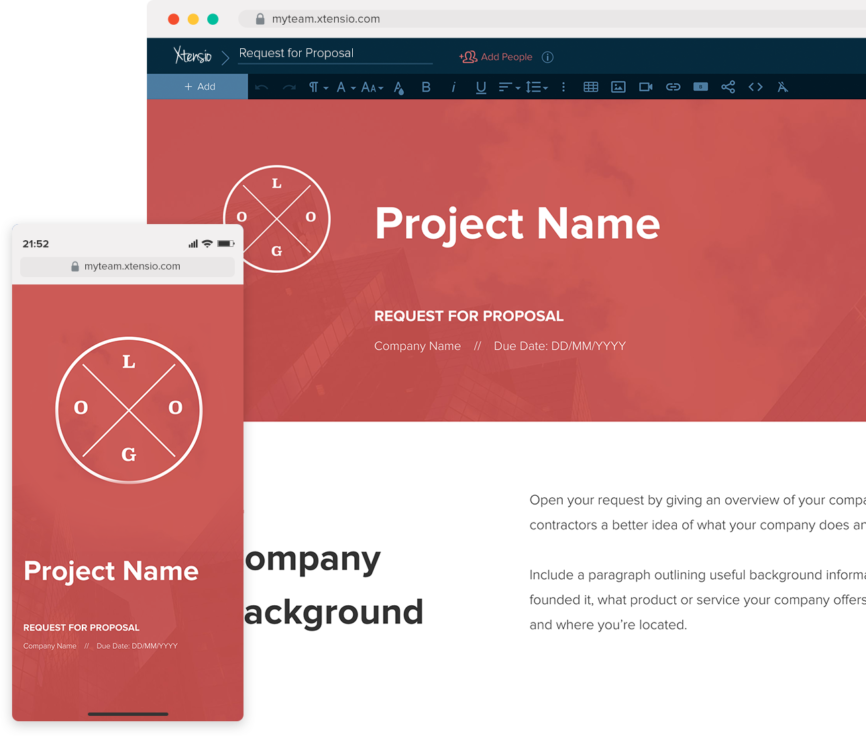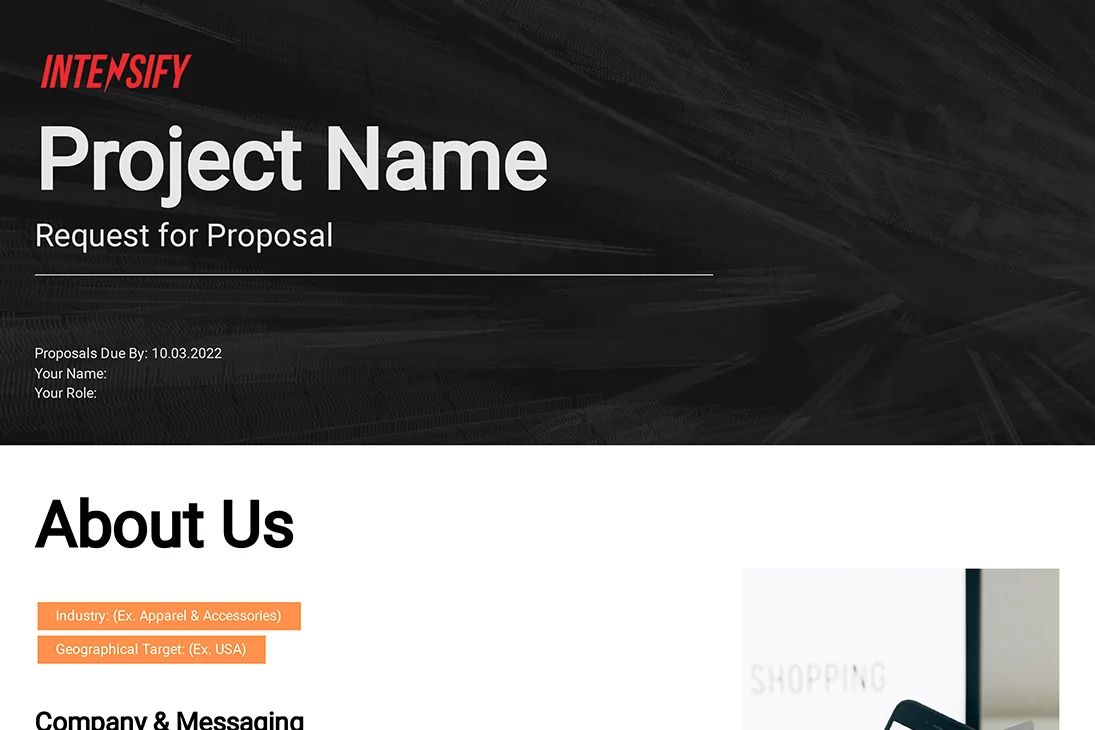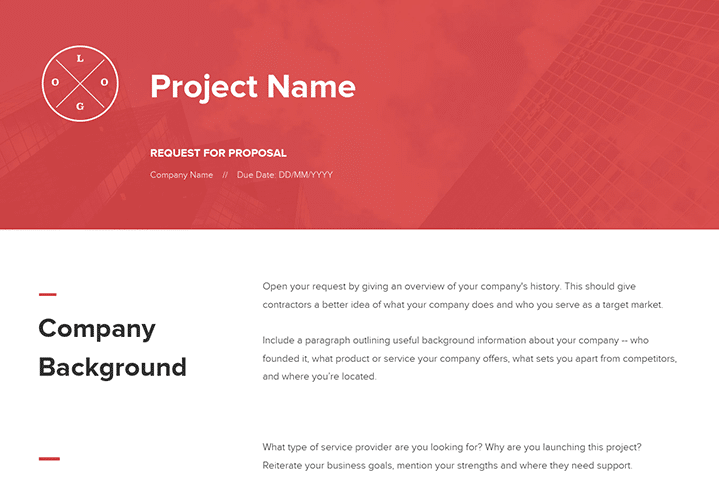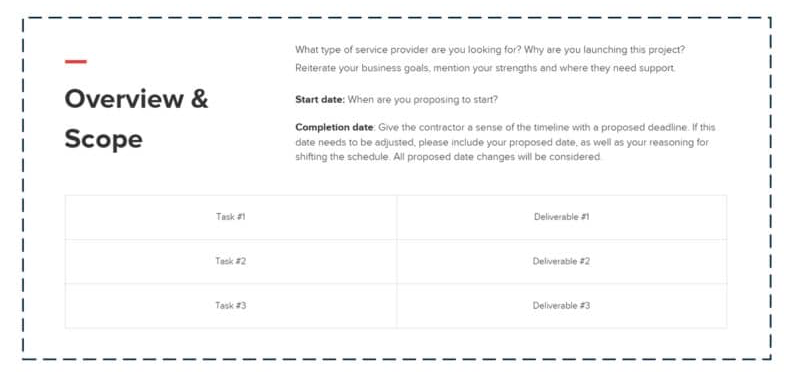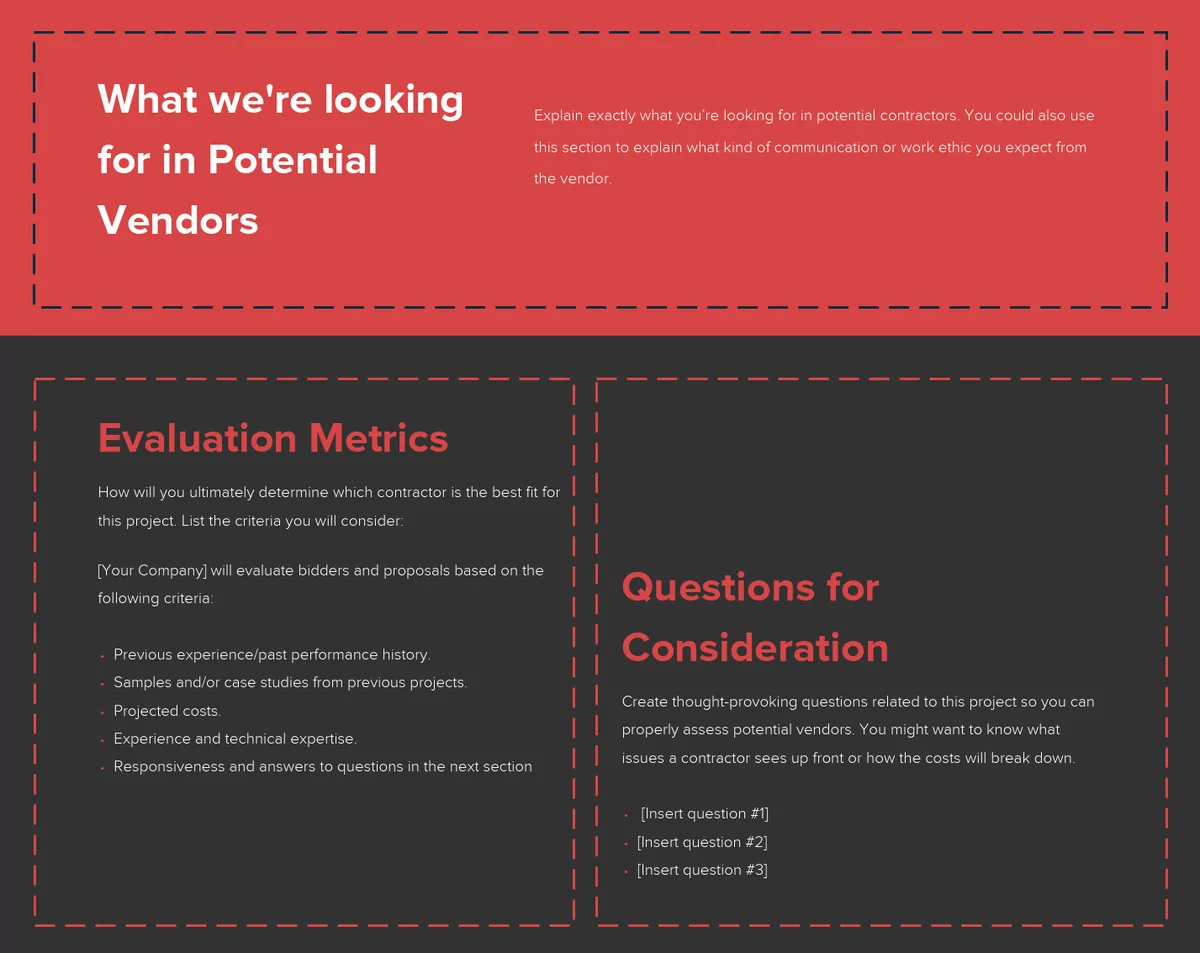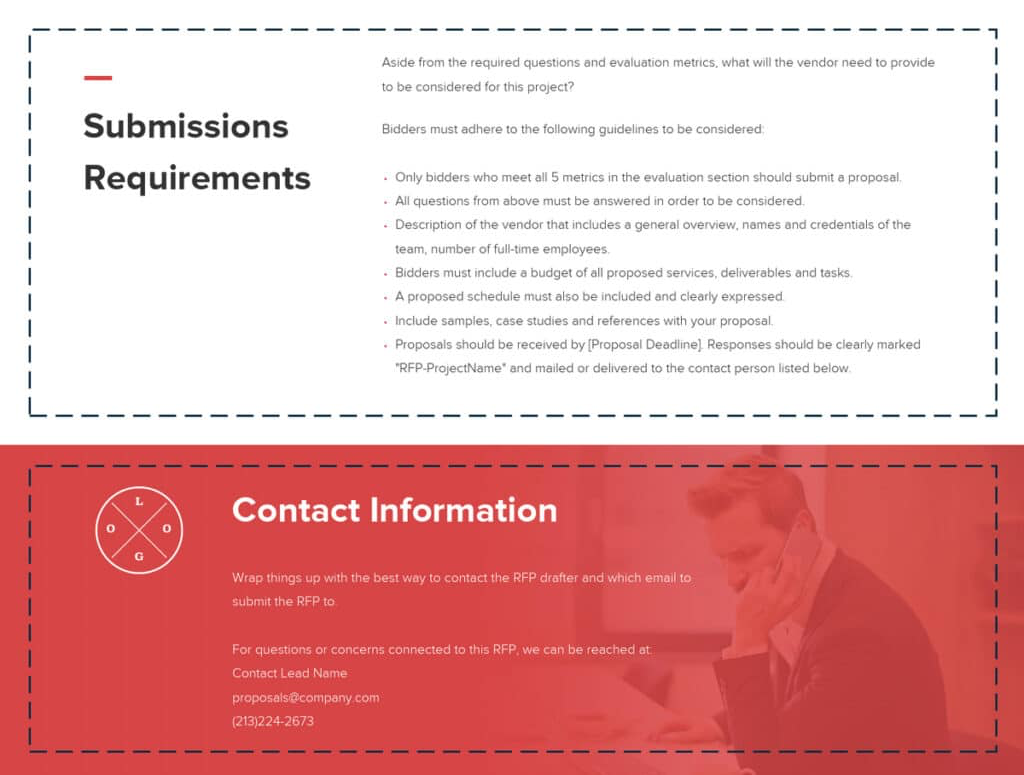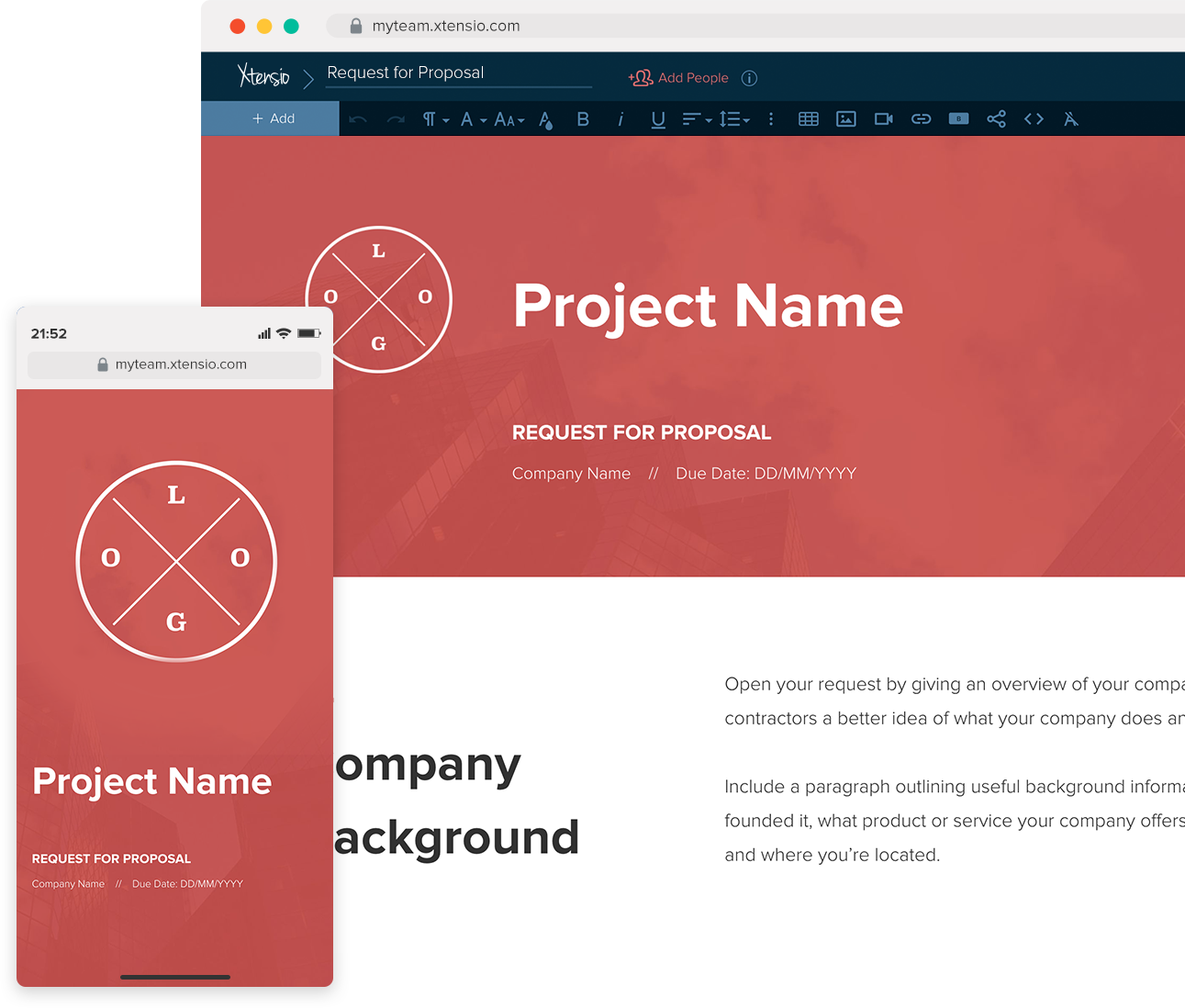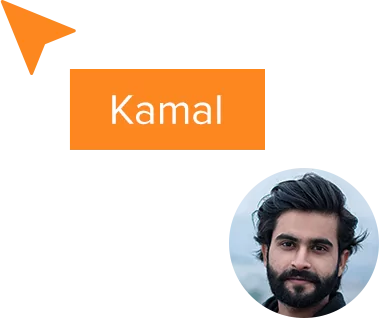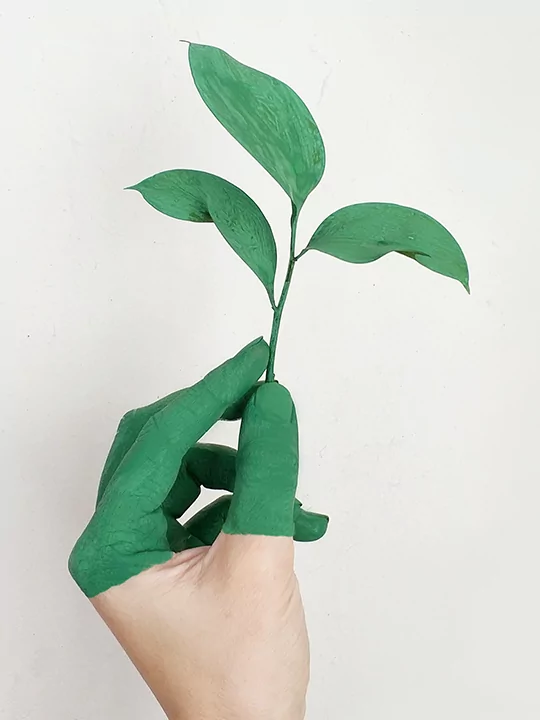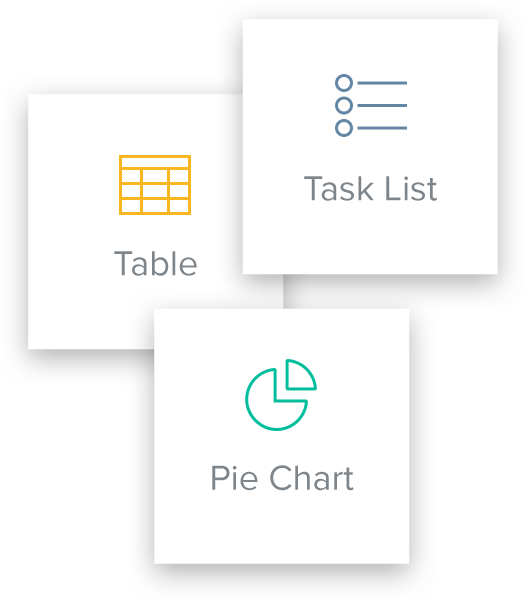How to Write a Request for Proposal – RFP (With Template and Examples)
Updated by Xtensio
RFPs: Requests for Proposals are how many professional consultancies and agencies win new work. It is a document that a business, non-profit or government agency creates to detail the requirements for an upcoming project. RFPs are shared to solicit bids from contractors who will help the company complete the project. Use this step-by-step guide to create and iterate on your request for proposal document, easily. Explore this template and read the complete guide.
Xtensio is your team space for beautiful living documents.
Create, manage and share business collateral, easily.
Table of Contents
Everything you’ll need to craft a winning request for proposal
When launching a project, it’s critical that all project stakeholders are aware of the partnership’s desired outcomes. That’s where a business requirements document (BRD) comes in handy. Generally, a BRD is used to detail a business’s needs when seeking a new technology provider, consultant, or outside vendor.
The request for proposal template (RFP) is a business document that announces and provides details about a project your company is launching. The goal of the request for proposal is to help you solicit and review bids from contractors who will help complete the project. Use Xtensio’s live template to keep everyone instantly up-to-date on the project details.
- Detail your project’s needs in a visual, easy-to-read RFP format to solicit and review bids from outside vendors.
- Ensure transparency and hold your organization and outside vendors accountable for project goals.
- Create benchmarks to measure a project’s success.
With Xtensio, you can easily create RFP documents tailored to your projects and needs. Loop in colleagues, clients, and key stakeholders to create and iterate on your request for proposal. You can work hand-in-hand with colleagues on a live doc, leave feedback, and share a link so everyone has the information they need to complete your projects.
Xtensio’s FREE Request for Proposal Templates
Your starting point to create and share a successful Request for Proposal,
without any design experience.
Create your request for proposal document header
RFPs come in all shapes, sizes, and visual formats depending on the needs of your company and the project you’re looking to receive bids. But the basic structure of BRD will essentially be the same regardless of your project, goals, and vendor requirements. Introduce your request for proposal document with your company name and logo, add the project name, the name of the person who created the RFP document, and the due date. You can also update the folio color scheme and background to match your company branding.

QUICK TIP: Once you set up your header section, you can save a custom template to easily repurpose for other RFP docs.
Explain who your company is
Open your request by giving an overview of your company’s history. This should give potential contractors and vendors a better idea of what your company does and who you serve as a target market.
Include a paragraph outlining useful background information about your company — who founded it, what product or service your company offers, what sets you apart from competitors, and where you’re located.
Detail the project overview and scope
One of the things that frustrate vendors and contractors interested in responding to an RFP is unclear expectations. When you write the RFP, strive for transparency whenever possible. What type of service provider are you looking for? Why are you launching this project? Reiterate your business goals, and mention your strengths, and where they need support. When are you proposing to start?
What’s the date for when the project should be wrapped up? Give the contractor a sense of the timeline with a proposed deadline. Add a note for potential contractors to adjust the date and include a reason for the shift if you’re open to alternative timelines. This section should also include an overview of tasks and deliverables that are required for the project.
Explain exactly what you’re looking for in a vendor
Explain exactly what you’re looking for in potential contractors. What kind of communication or work ethic do you expect from the vendor?
You’ll want to outline evaluation metrics. How will you ultimately determine which contractor is the best fit for this project? List the criteria you will consider, such as:
- Previous experience/past performance history.
- Samples and/or case studies from previous projects.
- Projected costs.
- Experience and technical expertise.
- Responsiveness and answers to questions in the next section.
You should also ask questions you’d like to ask potential vendors. Create thought-provoking questions related to this project so you can properly assess potential vendors. You might want to know what issues a contractor sees up front or how the costs will break down.
Identify the high-level project goals
Identify what you hope to accomplish with this project. What goals is your company hoping to achieve with this project? What KPIs will be analyzed to determine the success of this project?
Briefly describe the objective and list any specific KPIs or metrics you’ll be analyzing to determine if each of your goals has been reached.
Highlight existing roadblocks
Every project has inherent roadblocks that may cause delays or even failure of a project. Outline any time, resource or other constraints that will affect both the contractor’s proposal and the project as a whole. By explaining any roadblocks or issues upfront, you’ll weed out contractors who can’t tackle these constraints and connect with companies that know how to work around these issues.
- Are you dealing with custom coding or outdated technology?
- Does your team have limited resources?
- Are there any time constraints?
Detail the target deliverable schedule and timeline
Layout the timeline for when each deliverable should be delivered by. This should be included so potential vendors can gauge if they have the resources and bandwidth to complete the job on time. Rearrange your timeline according to the length of your proposed engagement and the structure of your workflow.
Consider these questions for different project milestones:
- How are you kicking off the project?
- What do you expect to achieve or be delivered each week?
- Any particular milestones for each week/step in the timeline?
Clearly state your budget
It’s important to be upfront with your budget. The more you can eliminate surprises, the better for all parties involved. What is the total that your company can spend on this project? Are there any constraints in the budget or any room for adjustments?
Outline submission requirements and provide contact information
Aside from the required questions and evaluation metrics you detailed further up in your RFP, explain what the vendor will need to provide to be considered for this project. Some things to think about:
- Only bidders who meet all 5 metrics in the evaluation section should submit a proposal.
- All questions from above must be answered in order to be considered.
- Description of the vendor that includes a general overview, names, and credentials of the team, and number of full-time employees.
- Bidders must include a budget for all proposed services, deliverables, and tasks.
- A proposed schedule must also be included and clearly expressed.
- Include samples, case studies, and references with your proposal.
- Proposals should be received by the deadline. Responses should be clearly marked “RFP-ProjectName” and mailed or delivered to the contact person listed below.
Finally, wrap your request for proposal up with the best way to contact the RFP drafter and which email to submit the RFP to.
Share your request for proposal document as a link, monitor, evaluate & iterate
When you’ve finished creating your RFP with Xtensio’s editor, you can send the live link to share it as a responsive webpage (and add password protection), export a PDF or present it as a slideshow in a meeting. The request for proposal template is adaptable just like other Xtensio tools, it can and should be repurposed, revisited, and revised regularly.
Looking for a different design or content for your RFP?
Check out the Agency RFP Template we created with the Los Angeles based marketing agency Intensify.
